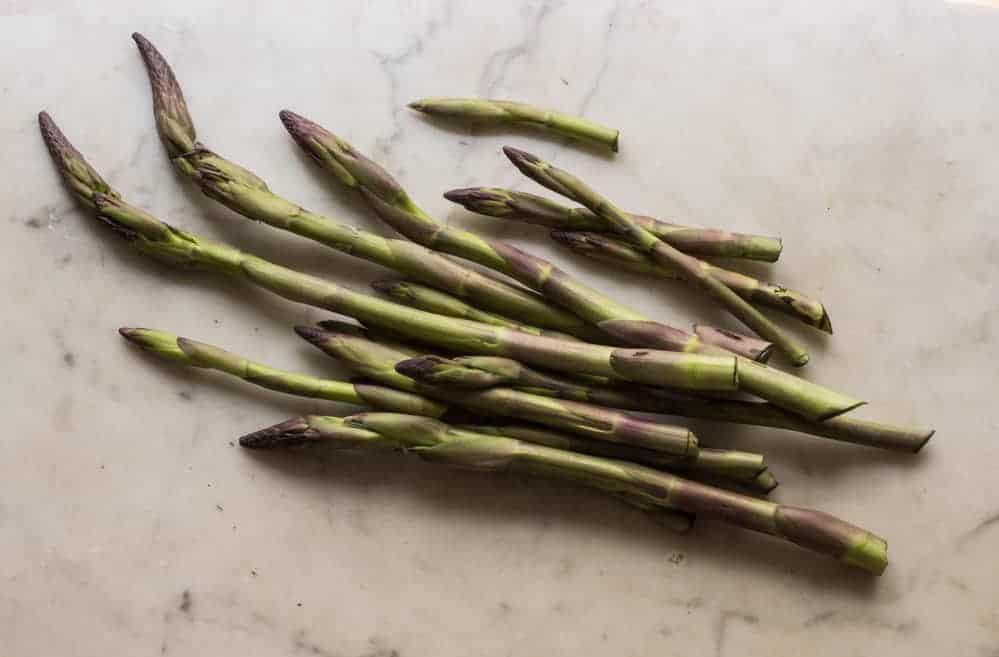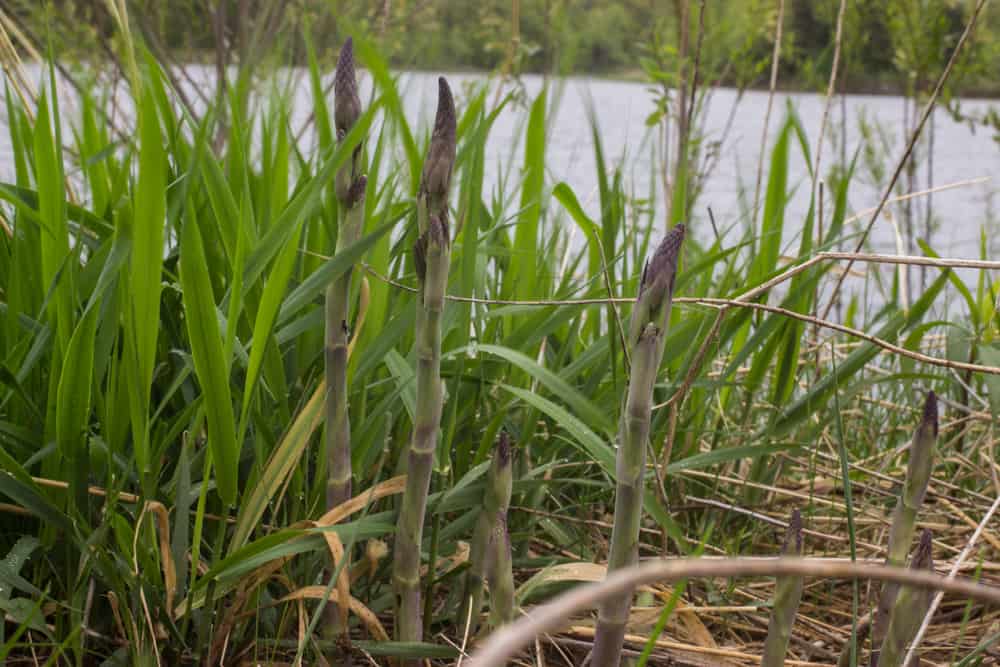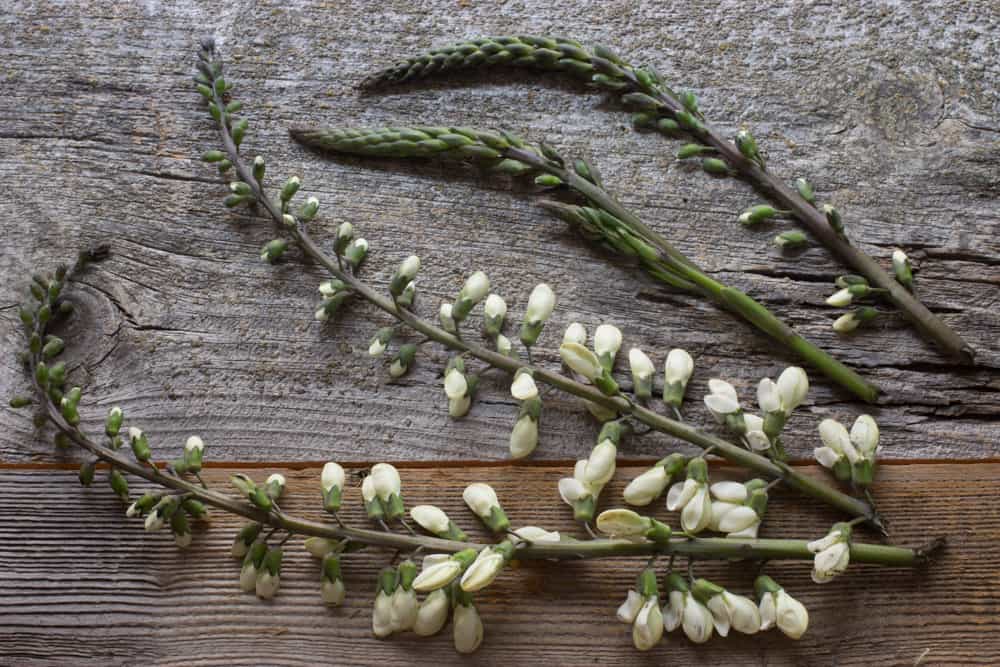Wild asparagus has a few look alikes. Some of them, like baptisia, you won't want to eat. Read on and I'll show you how to tell the differences between the two.

I was up early hunting morels at a spot I have that’s open and next to water, a beautiful oak savannah with the occasional elm here and there. Before I could grab my first morel another plant got my attention-slender shoots of some pretty wild asparagus, green and mottled with purple.

Seeing asparagus in different forms and colors is typical for me, and I love celebrating the season by using multiple types (especially the purple). I sliced a shoot or two off and took them home for inspection.

When I got to them the next day though, I could tell something wasn’t right, the stalks became extremely limp after just one night in the fridge, and the portion I cut on the bottom of the stalks had turned black/grey. I’ve seen some interesting types of asparagus, but this wasn’t one of them.

There’s a natural tendency that people (including myself) have when they come across new things while foraging, and Sam Thayer covers it well in his first book Forager's Harvest.
In a nutshell you’re looking for food to eat, you *want* food to eat. If you find something attractive you’re unfamiliar with, you want it to be edible and even if it’s not, your mind can make it conform to a description of something that is.
I started doing research online looking for “asparagus look a likes”, but still, no dice. There just really wasn’t too much info. Guide books weren’t any help either, they describe asparagus in detail, but nothing that looks similar.
I was pretty curious now, so I shot some pictures over to my friend Kenton, the creative force behind ReWild University in Wisconsin, whose much better with plants than me. Even he was stumped though.
Part of the conundrum is that plants will change their shape as they grow, and certain things will look much different young in the spring than in the summer and fall when seeds, fruits, and other tell-tale reproductive ID characteristics become visible.
Determined to figure out what the asparagus imposter was, I took some pictures and decided to be patient. A month later I went back to monitor it’s growth, sure enough, the crazy shoots got even more interesting, and spouted off a bunch of white flowers.

I started asking my friends online in message boards and discussion forums, armed with pictures of the shoots both young and flowering.
My friend Sam Shaperow, a well known hunter and eater of things on the East Coast was a great help here, and shot a couple pictures to Sam Thayer for me, who said it looked like it resembled Baptisia, which is something you don’t want to eat. The species pictured here should be Baptisia alba.

I felt like I’d cheated since I hadn’t pin-pionted a latin binomial in a field guide myself, but if there’s one thing I’ve learned in life it’s that asking for help is ok, especially from people that know a lot more than you do. Wouldn’t you know, all the pictures and info I could find on Baptisia were dead-ringers for my asparagus imposter.

Vallary Van Eaton
I was cleaning up dead growth along the fence and thought I’d come across asparagus. This is our first spring in our new home and I figured anything is possible. Upon closer inspection something looked off because I’ve grown asparagus before and some of the spears look as if they’re about to unfurl or flower. I looked up look alike asparagus and found this post. I want to share my pictures.
Greg
I think asparagus is the mimic. The original is the horsetail which dates back hundreds of millions of years. I think natural selection created the asparagus to look like the poisonous horsetail.
Fucking pedant
Horsetails in general are not poisonous
Tina M Aide
Thank you! I know what Baptisia alba looks like "all grown up" but I never saw it in it's little asparagus copycat stage. I have also dug and dug for information related to asparagus in the wild. This may help me in the future. We are supposed to have it in my region. I love edible wild plants, but after over 12 years of foraging and studying, I have learned that I know nothing, unless it is something I have already eaten and unless I truly know the "exact" characteristics. I have recently moved to TN Appalachian Mountains, which puts me on a whole new plain... back down the ladder many rungs. We have so many things that are new to me. I've seen them in books, but until you know it in person, you must check and recheck. I own a health food store and try to teach people self-reliance with wild functional foods, things with medicinal properties. Again... Many thanks! Now to find my YOUNG asparagus fern-like imposter(s).
Alan Bergo
Glad I could help.
Kerri
I just found this post after googling asparagus lookalikes for probably the 20th time this month. I've never found wild asparagus, but, while staying in Lassen National Forest, I came across some small skinny shoots shaped just like asparagus and wondered if I had. But you're right, there is so little information and so few photos of all the different stages and appearances, I had no idea. It didn't seem to be growing as fast as asparagus is described as growing, and it had a very definite red tint — but since it was so difficult to find an array of photos of asparagus at that stage of growth, I didn't rule it out. Maybe it can actually be that color when very immature? I had no idea since it was so hard to reference. It wasn't until a few days later when I came upon a tiny flowering orchid whose stem was suspiciously the same color, and I recognized the shape. I had been looking at immature Spotted Coral Root Orchids (Corallorhiza maculata).
Now I'm in another national forest and having a similar quandary. I came upon a patch of stumpy white spears that look *just* like white asparagus. They're growing under a thick grove under pine needles—just the right conditions to make them white. But, again, everything I've read says these things grow inches in a day, and they've barely grown a half inch since I started observing them four days ago. And I wonder how a patch would start growing down some national forest road? And I don't see any telltale ferny leaves around them. And it was so difficult to find *any* info on asparagus lookalikes to begin with, I doubt if I'd ever know if I should be looking out for some "white asparagus" lookalike… oh well, they won't be big enough to forage anyway by the time I leave. But, if not asparagus, I'm dying to know what they are!
Alan Bergo
Possibly horsetail? IDK. Hard to guess without pictures. If you have any you can send to my email. alanbergo3 @ gmail
Dewi
Hi. I am from the north side of south america. It is extremely warm and tropical place. Asparugus is for us a foreign grocery. We import these grocery because we are open for tourists and foreigners. I am not expecting asparugus to grow here, but I find a plant and its shoots just in my garden that really looks like asparagus. I would love to send these pics, if anyone can ensure me what it is. I have taken the risc to cook and taste 1 shoot, not really know how it taste like, and i am still here. The fact that it grows here is really odd. My mother use this plant for her bouqette.
Alan Bergo
Hi Dewi. Thanks for sharing. Feel free to send your pictures to me: alanbergo3@gmail.com
Alan.
Ryan
I have to disagree with Thayer's assessment. It isnt that your mind makes something conform to what you want, it's that you make a mental shortcut of "X plant has X shape and Y plant has Y shape" and so your unconscious picks up the general appearance and says "hey, this might be X or Y" and then when you find out that not it's not, you find tune the mental shortcut to be able identify things better.
Objectively the Baptisia looks almost exactly like asparagus at that stage. It looked like it even after I read the title of your post. And if you were to cut off the tips they would look exactly like asparagus.
Very interesting find otherwise, wonder if you could plant Baptisia in a garden
Ellie G
I have an asparagus lookalike that I'm trying to identify too! It's big, purple and yellow inside. I left it out to dry and the skin has gone fluffy. Any ideas?
Alan Bergo
Pictures help. I would inquire with one of the plant identification groups on Facebook. The collective mind has never failed me there.
Dave Knox
I have a few dozen of these growing in a field. I rescued the seeds from a piece of native prairie the bulldozer crazed neighbor was destroying.
Alan Bergo
Good for you for saving them, just because we shouldn't eat them doesn't mean they're not beautiful.
Blayne Puckett
so how harmful to humans is this impostor? how much would be lethal for a 250lb male?
Alan Bergo
I don't know, I haven't eaten it.
Mike
I work for a county here in MN and specialize in plants. Another plant specialist and our head ecologist all confused this for asparagus and we all ate a bite in the field. It wasn't until I found it flowering that I realized what it is. B. lactea is the accepted latin in MN, and it is also a species of special concern due to habitat loss, so hopefully this article will steer people away from picking it in the future, thanks!
ken
baptisia is one one of the best if not the best wild plant for boosting immune system there are a few different species used am not possative but i think they can all be used one way or another imaybe not all internaly though baptisia tinctora and baptisa astragalus are both roots r used for as tinctures for boosting immune system with great results only a tiny amount daily is needed
Liz Terrance
🙁 According to this, 2 people were poisoned making the same mistake you almost made:
http://www.ncbi.nlm.nih.gov/pubmed/25453859
Liz Terrance
Excellent post! I know what you mean about tricking yourself into seeing what you want and expect to see. That really does look tasty too--so I'm glad you weren't fooled!
eric tischler
Thanks for sharing. They really do look like asparagus. Its on my bucket list to find some this year, I will be more careful now. Thanks
Alan Bergo
No prob my friend.
Jan Wirth
My first thought was hops shoots.
Alan Bergo
Love hop shoots!
Andrea Wyckoff
Wow! Woulda fooled me too. It looks so much like l asparagus! Thanks for sharing!!